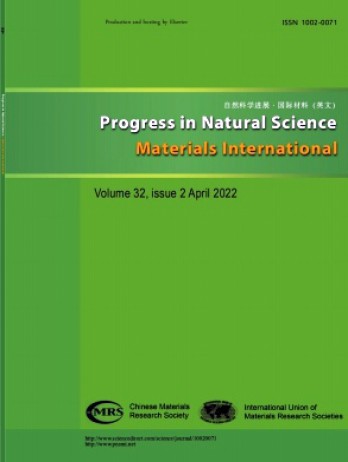
Progress in Natural Science:Materials International雜志簡介
《Progress in Natural Science:Materials International》(月刊)1990年創(chuàng)刊,是國家自然科學(xué)基金委員會和中國科學(xué)院主辦的綜合性學(xué)術(shù)月刊。
《Progress in Natural Science:Materials International》是反映現(xiàn)今材料科學(xué)和技術(shù)領(lǐng)域最新研究成果的專業(yè)學(xué)術(shù)期刊。刊登自然科學(xué)各學(xué)科領(lǐng)域的基礎(chǔ)研究和應(yīng)用基礎(chǔ)研究方面的高水平、有創(chuàng)造性和重要意義的最新研究成果論文,國內(nèi)外發(fā)行,以促進國內(nèi)外學(xué)術(shù)交流。本刊設(shè)專題評述、學(xué)術(shù)論文、研究簡訊、實驗室通訊和書評與學(xué)術(shù)論壇。
Progress in Natural Science:Materials International發(fā)文方向
專題評述、學(xué)術(shù)論文、研究簡訊、學(xué)術(shù)論壇、實驗室通訊
Progress in Natural Science:Materials International雜志特色
Article structure
Subdivision-numbered sections
Divide your article into clearly defined and numbered sections. Subsections should be numbered 1.1 (then 1.1.1, 1.1.2, ...), 1.2, etc. (the abstract is not included in section numbering). Use this numbering also for internal cross-referencing: do not just refer to 'the text'. Any subsection may be given a brief heading. Each heading should appear on its own separate line.
Introduction
State the objectives of the work and provide an adequate background, avoiding a detailed literature survey or a summary of the results.
Material and methods
Provide sufficient detail to allow the work to be reproduced. Methods already published should be indicated by a reference: only relevant modifications should be described.
Abstract
An abstract of 200 words or less should precede the introduction. The abstract should clearly indicate the nature of the manuscript and the results described therein.
A concise and factual abstract is required. The abstract should state briefly the purpose of the research, the principal results and major message. An abstract is often presented separately from the article, so it must be able to stand alone. For this reason, References should be avoided, but if essential, they must be cited in full, without reference to the reference list. Also, abbreviations should be avoided, but if essential they must be defined at their first mention in the abstract itself.
Keywords
Immediately after the abstract, provide 5 keywords, avoid general and plural terms and multiple concepts (avoid, for example, "and", "of"). These terms should be relatively independent (coordinate index terms) and, as a group, should optimally characterize the paper. Be sparing with abbreviations: only abbreviations firmly established in the field may be eligible. These keywords will be used for indexing purposes. Use keywords that make your paper easy detectable for interested readers in literature databases. Repeating terms in the title is usually not needed.
雜志收錄與榮譽
我們提供的服務(wù)
在線客服
一對一咨詢服務(wù)、簡單快捷、省時省力
了解更多 >快遞配送
直郵到家、實時跟蹤、更安全更省心
了解更多 >雜志訂閱
去除中間環(huán)節(jié)享受低價,物流進度實時通知
了解更多 >雜志推薦
正版雜志,匹配度高、性價比高、成功率高
了解更多 >期刊導(dǎo)航
相關(guān)標(biāo)簽:
基礎(chǔ)科學(xué)綜合 自然科學(xué)理論與方法 數(shù)學(xué) 非線性科學(xué)與系統(tǒng)科學(xué) 力學(xué) 物理學(xué) 生物學(xué) 天文學(xué) 自然地理學(xué)測繪學(xué) 氣象學(xué) 海洋學(xué) 地質(zhì)學(xué) 地球物理學(xué) 資源科學(xué)
期刊收錄:
CSCD期刊SCI期刊上海圖書館館藏知網(wǎng)收錄(中)萬方收錄(中)國家圖書館館藏文摘與引文數(shù)據(jù)庫維普收錄(中)SCI 科學(xué)引文索引(美)JST 日本科學(xué)技術(shù)振興機構(gòu)數(shù)據(jù)庫(日)CSCD 中國科學(xué)引文數(shù)據(jù)庫來源期刊(含擴展版)CA 化學(xué)文摘(美)
常見問題
相關(guān)期刊
友情鏈接
免責(zé)聲明
若用戶需要出版服務(wù),請聯(lián)系出版商,地址:北京海淀區(qū)雙清路83號,郵編:100083。